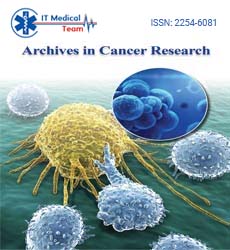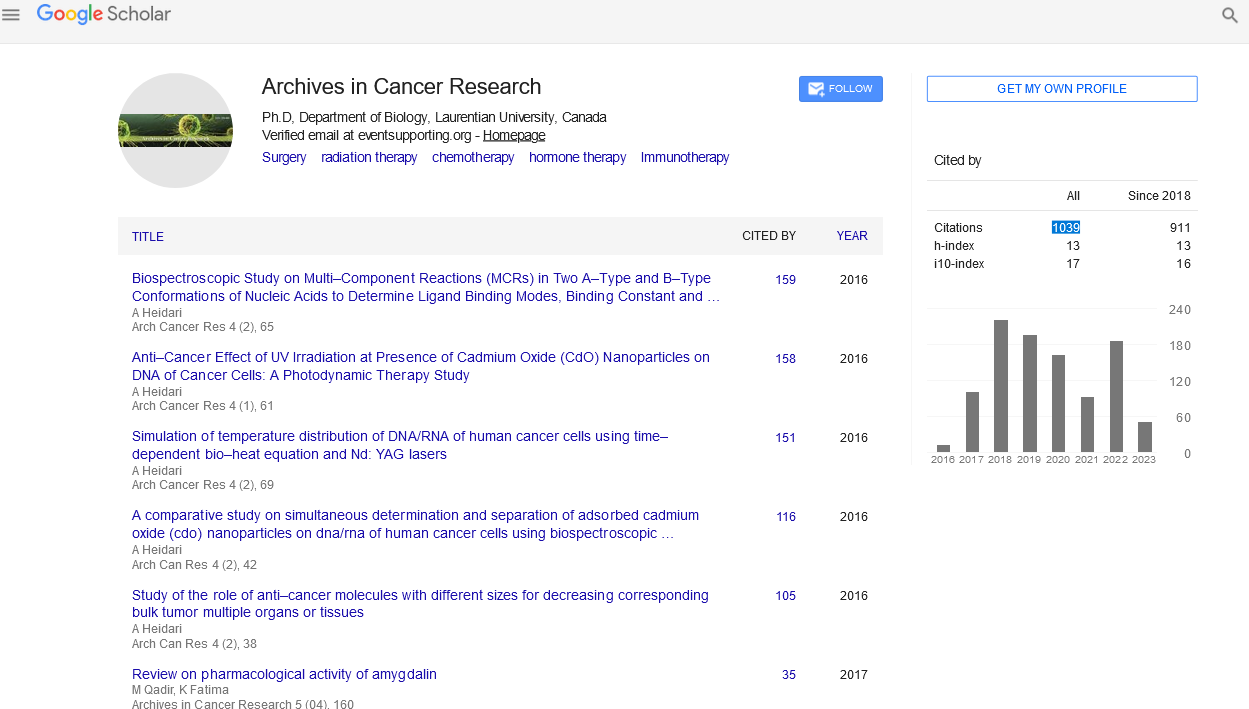Perspective - (2024) Volume 12, Issue 4
Understanding Glioma: An In-depth Look at Brain Tumors
Ritu Idowu*
Department of Cancer Biology, University of Texas, MD Anderson Cancer Center, Houston, USA
*Correspondence:
Ritu Idowu, Department of Cancer Biology, University of Texas, MD Anderson Cancer Center, Houston,
USA,
Email:
Received: 16-Jul-2024, Manuscript No. IPACR-24-15001;
Editor assigned: 18-Jul-2024, Pre QC No. IPACR-24-15001 (PQ);
Reviewed: 01-Aug-2024, QC No. IPACR-24-15001;
Revised: 12-Aug-2024, Manuscript No. IPACR-24-15001 (R);
Published:
19-Aug-2024
Introduction
Gliomas are a group of tumors that arise from the glial cells in
the brain and spinal cord. Glial cells provide support and
protection for neurons, the primary cells that carry information
in the nervous system. Gliomas are among the most common
types of primary brain tumors and can vary significantly in their
behavior and prognosis. This article delves into the different
types of gliomas, their causes, symptoms, diagnosis, treatment
options, and ongoing research, providing a comprehensive
understanding of this complex and challenging disease.
Description
Types of gliomas
Gliomas are classified based on the type of glial cell they
originate from, as well as their grade, which indicates their level
of malignancy and growth rate. The World Health Organization
(WHO) grading system ranges from I (least malignant) to IV
(most malignant).
Astrocytomas
These tumors originate from astrocytes, star-shaped glial cells
that support neurons. Astrocytomas are graded from I to IV:
Pilocytic astrocytoma (Grade I): A slow-growing tumor
typically found in children.
Diffuse astrocytoma (Grade II): A slow-growing but infiltrative
tumor.
Anaplastic astrocytoma (Grade III): A more aggressive and
malignant form.
Glioblastoma (Grade IV): The most aggressive and common
type of glioma in adults, known for its rapid growth and poor
prognosis.
Oligodendrogliomas
These tumors arise from oligodendrocytes, which produce the
myelin sheath that insulates nerve fibers. Oligodendrogliomas
are typically graded as:
Oligodendroglioma (Grade II): A slow-growing tumor that can
become more aggressive over time.
Anaplastic oligodendroglioma (Grade III): A more malignant
form with a worse prognosis.
Ependymomas
These tumors develop from ependymal cells lining the
ventricles of the brain and the central canal of the spinal cord.
They are graded as:
Ependymoma (Grade II): A tumor that can recur but is
generally less aggressive.
Anaplastic ependymoma (Grade III): A more aggressive and
malignant tumor.
Mixed gliomas: These tumors contain a mix of different glial
cell types, such as oligoastrocytomas, which have both astrocytic
and oligodendroglial components.
Causes and risk factors
The exact cause of gliomas remains largely unknown, but
several risk factors have been identified:
Genetic factors: Certain inherited genetic syndromes, such as
Li-Fraumeni syndrome, Neurofibromatosis type 1 and 2, and
Turcot syndrome, increase the risk of developing gliomas.
Environmental factors: Exposure to ionizing radiation, such as
radiation therapy used to treat other cancers, has been linked to
an increased risk of gliomas. However, the role of other
environmental factors, such as mobile phone use, remains
controversial and inconclusive.
Age: Gliomas can occur at any age but are more common in
adults between the ages of 45 and 65. Certain types, such as
pilocytic astrocytomas, are more common in children.
Gender: Gliomas are slightly more common in males than
females, although the reasons for this disparity are not well
understood.
Symptoms
The symptoms of gliomas vary depending on the tumor's
location, size, and rate of growth. Common symptoms include:
Headaches: Persistent headaches, often more severe in the
morning or during physical activity, are a common symptom.
Seizures: Seizures are a frequent initial symptom, particularly
in low-grade gliomas.
Neurological deficits: Depending on the tumor's location,
patients may experience weakness, sensory changes, difficulty
with coordination, or changes in vision or speech.
Cognitive and behavioral changes: Memory loss, confusion,
personality changes, and difficulty concentrating can occur as
the tumor affects brain function.
Nausea and vomiting: Increased intracranial pressure due to
tumor growth can cause nausea and vomiting.
Diagnosis
Diagnosing gliomas involves a combination of clinical
evaluation, imaging studies, and biopsy.
Neurological examination: A thorough neurological
examination helps assess cognitive function, coordination,
reflexes, and sensory and motor skills.
Imaging studies: Magnetic Resonance Imaging (MRI) is the
gold standard for diagnosing and characterizing brain tumors. It
provides detailed images of the brain's structure and can help
determine the tumor's size, location, and extent. Computed
Tomography (CT) scans may also be used, particularly in
emergency settings.
Biopsy: A biopsy involves removing a small sample of the
tumor tissue for microscopic examination. This procedure is
crucial for confirming the diagnosis and determining the tumor's
grade. In some cases, a stereotactic needle biopsy is performed,
while in others, a craniotomy (surgical removal of part of the
skull) may be necessary.
Molecular testing: Molecular and genetic testing of the tumor
tissue can provide additional information about specific
mutations and biomarkers, which can influence treatment
decisions. For example, the presence of an IDH1 or IDH2
mutation or 1p/19q co-deletion can impact prognosis and
treatment options in gliomas.
Treatment options
Treatment for gliomas depends on the type, grade, location,
and size of the tumor, as well as the patient's overall health and
preferences. The main treatment modalities include surgery,
radiation therapy, and chemotherapy.
Surgery: Surgical resection is often the first line of treatment
for gliomas, aiming to remove as much of the tumor as possible
while preserving neurological function. The extent of resection
significantly impacts prognosis, with more complete removals
associated with better outcomes. Advanced surgical techniques,
such as intraoperative MRI and awake craniotomy, help
maximize tumor removal while minimizing damage to healthy
brain tissue.
Radiation therapy: Radiation therapy uses high-energy beams
to target and kill cancer cells. It is commonly used after surgery
to eliminate any remaining tumor cells and reduce the risk of
recurrence. Several types of radiation therapy are used to treat
gliomas:
External Beam Radiation Therapy (EBRT): This is the most
common form of radiation therapy, delivering radiation from
outside the body. Techniques such as Intensity-Modulated
Radiation Therapy (IMRT) and stereotactic radiosurgery (SRS)
allow for precise targeting of the tumor while sparing healthy
tissue.
Proton therapy: Proton therapy uses protons instead of X-rays
to deliver radiation, allowing for more precise targeting and
potentially reducing side effects.
Brachytherapy: Brachytherapy involves placing radioactive
sources directly into or near the tumor. It is less commonly used
for gliomas but can be an option in certain cases.
Chemotherapy: Chemotherapy uses drugs to kill cancer cells
or stop their growth. It is often used in combination with surgery
and radiation therapy to treat gliomas. The most commonly
used chemotherapy drug for gliomas is temozolomide, which
can be taken orally and crosses the blood-brain barrier. Other
chemotherapeutic agents, such as carmustine and lomustine,
may also be used.
Targeted therapy and immunotherapy: Advances in
understanding the molecular biology of gliomas have led to the
development of targeted therapies and immunotherapies. These
treatments aim to specifically target cancer cells or enhance the
body's immune response against the tumor.
Targeted therapy: Targeted therapies, such as bevacizumab
(an anti-VEGF antibody), aim to inhibit specific pathways
involved in tumor growth and angiogenesis (formation of new
blood vessels).
Immunotherapy: Immunotherapy approaches, such as
checkpoint inhibitors (e.g., pembrolizumab) and CAR-T cell
therapy, are being investigated for their potential to harness the
immune system to fight gliomas.
Prognosis and survival rates
The prognosis for glioma patients varies widely based on the
tumor type, grade, and location, as well as the patient's age and
overall health. Low-grade gliomas generally have a better
prognosis than high-grade gliomas, but they can still be lifethreatening
due to their potential to progress to higher grades.
Glioblastoma (Grade IV): Glioblastoma is the most aggressive
form of glioma, with a median survival of approximately 15
months despite aggressive treatment. However, some patients
live much longer, particularly with advances in personalized
treatment approaches.
Anaplastic astrocytoma (Grade III): The median survival for
patients with anaplastic astrocytoma is approximately 2-3 years.
Low-gr ade gliomas (Grade II): Patients with low-grade
gliomas can survive for many years, with median survival ranging from 5 to 15 years, depending on the specific tumor type and
molecular characteristics.
Pediatric gliomas: The prognosis for children with gliomas
varies widely. Pilocytic astrocytomas (Grade I) often have an
excellent prognosis with surgical resection, while high-grade
gliomas in children have a poorer outlook.
Research and future directions
Ongoing research is crucial for improving the understanding
and treatment of gliomas. Several areas of research hold
promise for future advances:
Genomic and molecular research: Understanding the genetic
and molecular underpinnings of gliomas is key to developing
targeted therapies. Large-scale genomic studies, such as The
Cancer Genome Atlas (TCGA), have identified numerous genetic
alterations in gliomas, paving the way for new treatment
approaches.
Clinical trials: Clinical trials are essential for testing new
therapies and improving outcomes for glioma patients. Trials are
investigating novel agents, combinations of existing treatments,
and innovative approaches such as Tumor-Treating Fields (TTF)
therapy, which uses electric fields to disrupt cancer cell division.
Personalized medicine: Personalized medicine aims to tailor
treatment to the individual characteristics of each patient's tumor. Advances in molecular profiling and biomarkers are
enabling more precise and effective treatment strategies.
Immunotherapy: Immunotherapy is a rapidly evolving field
with significant potential for treating gliomas. Researchers are
exploring various immunotherapeutic approaches, including
vaccines, checkpoint inhibitors, and adoptive cell therapies.
Artificial intelligence and machine learning: AI and machine
learning technologies are being applied to analyze large
datasets, improve diagnostic accuracy, and predict treatment
responses. These tools hold promise for advancing personalized
treatment and improving outcomes.
Conclusion
Gliomas are a diverse and challenging group of brain tumors
with varying prognoses and treatment options. Advances in
molecular biology, imaging, and treatment strategies are
continually improving the understanding and management of
gliomas. Continued research, clinical trials, and personalized
approaches offer hope for better outcomes and improved
quality of life for patients with gliomas. As the field progresses,
collaboration among researchers, clinicians, and patients will be
essential in driving forward the fight against this complex
Citation: Idowu R (2024) Understanding Glioma: An In-depth Look at Brain Tumors. Archives Can Res Vol:12 No:4





